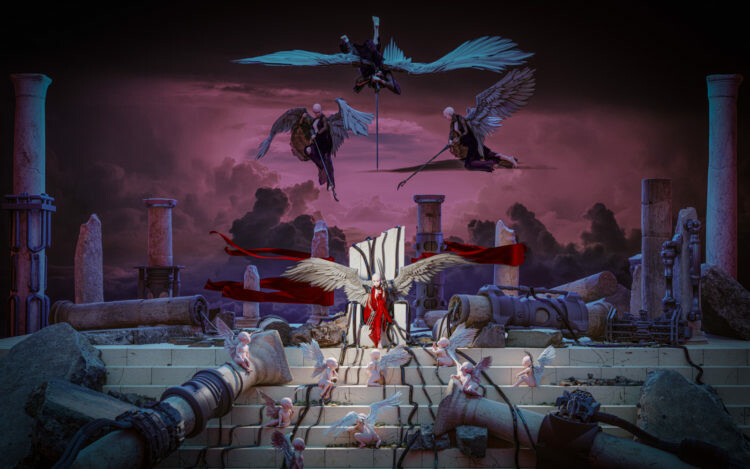“Gods in Hi-Res.” By Grimes and Mac Boucher
Sales of NFTs were said to have increased by 1700% between December 2020 and February 2021, with the average NFT selling for around $975 (£707). Locked in as the new Bitcoin-esque boom (but don’t be fooled, they’re not the same thing), NFTs are being hailed as the new token-based economy of the post-pandemic age.
We’ve heard through the virtual grapevine that an NFT can be pretty much anything digital. Think virtual art, JPEG files, audio clips, gifs – even Tweets have managed to be sold off for millions on the NFT market. However, the logistics behind an NFT – how it works and why its valuable – remain somewhat of a mystery. Surely a good ol’ copy and paste would do the job, right?
There’s a lot of confusion surrounding NFTs – and rightly so – but this shouldn’t make it something to avoid. We’ve put together a little starter pack to get our readers acquainted with the NFT: what it is, why it’s good, and why it’s not so good.
What the heck is an NFT?
Simply put, an NFT is a “non-fungible token”. Like Bitcoin, it has monetary value. Unlike Bitcoin, it’ not actually interchangeable currency. Rather than currency, an NFT is a token that acts as unique proof of ownership for something (that something being digital).
For example, if you bought a digital artwork as an NFT, that artwork would be tokenised to create a digital certificate of ownership. That certificate is the NFT – the thing being bought and sold. It’s a one-of-a-kind asset. So, what you’re really buying is the “authenticated original”, not the copy and paste version you can find anywhere on the internet.
This is where you find the resemblance to Bitcoin. Both Bitcoin and NFTs make a record of who owns what on a shared ledger known as a blockchain. A blockchain is an alternative database that is encrypted (made super secure) through a peer-to-peer network. In other words, it’s an extensive family tree connecting the owners of one NFT. This family tree can be used to track an NFT’s provenance and differentiate it from a copy and paste “fake”.
However, this is where the similarities to cryptocurrency end. Because an NFT is non-fungible, it can’t be used as currency. You can swap a Bitcoin with another Bitcoin, but you can’t swap an NFT for a Banksy artwork with an NFT for a pizza coupon – they aren’t the same value. NFTs aren’t money, they’re just very pricey collectables.
But as mentioned, this doesn’t stop the asset represented by an NFT from being copied, downloaded, or shared across the internet. And while the NFT can be sold on, the artist who created it can still retain copyright ownership – meaning they can continue to produce and sell copies of the same artwork. If anything, the NFT customer is simply buying bragging rights; they can say they own the “original” even as a million people download the same image, song, or whatever on their phone.
Still with us? Think of an NFT as owning the real Mona Lisa compared to the dodgy postcard you get in the giftshop. It’s unique, we know you got it from the creator, and you have the certificate to prove it. It just doesn’t exist physically.
So how do I buy an NFT?
There are multiple markets for NFTs, and certain NFTs are only available on specific platforms. For example, if you wanted to get your hands on an NBA Top Shot pack (think digital playing cards with licensed highlights from NBA games), then you would need to open an account with NBA Top Shot, create a digital wallet, and support that wallet with cryptocurrency.
But this doesn’t mean you can only buy an NFT with cryptocurrency – many markets will take real money too. More general marketplaces for NFTs include OpenSea, Nifty Gateway, Rarible, NFT Showroom, and Foundation.
The many possible uses for NFTs
The art market has arguably raked in the most benefits from NFTs so far. Back in February, a gif of a cat with a pop tart body, otherwise known as ‘Nyan Cat’, sold for 300ETH – which is roughly $561,000 or just over £407,000. The cat meme is thought to be one of the first items to open the NFT floodgates, with many artists since taking their work to the digital market in hopes of making it big.
In March, tech company Injective Protocol bought a physical Banksy artwork for $95,000 (£69,000), set it on fire over livestream, and then unveiled the digital copy as an NFT. The new digital token was sold for $380,000 (£274,000). That same month, a digital artwork by Beeple was sold at Christie’s auction house for $69m (£50m), making Beeple the third most valuable living artist in the world.
But as we’ve mentioned, an NFT isn’t just an artwork. It can be a video, a song, or even a social media post. An NFT of Twitter founder Jack Dorsey’s first tweet recently sold at auction for $2.9m (£2.1m), for example.
In the fashion world there has been a bit more hesitancy and uncertainty regarding how best to use an NFT. In an industry dominated by material products, the prospect of a digital product doesn’t seem to appeal so much. Or does it?
On April 4th, luxury watch brand Jacob & Co. will be launching an NFT watch through an auction with ArtGrails. The highest bidder will receive a digital rendering of a new Jacob & Co. watch, as well as the physical accoutrements that would usually come with a physical one (namely a certificate of ownership and a case). The collectible is the brand’s way of introducing the NFT market to the wider industry.
Danny Parisi of Glossy has indicated that the possibilities for NFTs in fashion doesn’t end here, either:
“A brand like Prada could embed an NFT in every physical product it sells and, for example, embed a ticket to a Prada fashion show in 10 randomly selected pairs of shoes. Or a streetwear brand could pair NFTs with sneaker drops, the way sneaker brand RTFKT Studios did last week when it sold 600 digital art NFTs paired with sneakers for $3.1 million total.”
Additionally, the pairing of NFTs with physical objects could be a good opportunity to track an item’s purchase history and authenticity, preventing the sale of counterfeits.
Business of Fashion have also noted that NFTs can also provide royalties to the original creator; an NFT can contain a smart contract that give an artist a cut of any future sale of that specific token. In terms of fashion, the original brand that created a product can earn royalties every time that product is resold.
But are NFTs actually any good?
An NFT provides several new ways to make money in a (currently) open market. The people on top of their game are making millions through NFT sales, riding a high that is shaking the internet to its core.
With the possibility to earn royalties too, it has been argued that NFTs offer a more direct route to profits. Lindsay Lohan, for example, recently put her new single, ‘Lullaby’, on the NFT market via FansForever. Lohan has advocated her support for the digital market on numerous occasions, and in an interview with Forbes stated:
“With tokenization, the process is transferred onto the blockchain in such a way that every time the art, music, movie, etc. is used or shared, the artist would automatically receive royalties. I think it’s a great way to bridge the gap between the consumer and artist.”
But are NFTs as bright and shiny as they seem?
Underlying environmental issues surrounding the production of NFTs have recently come into the spotlight, highlighting the more unethical practices of the market. A lot of computer power is needed to encrypt the tokens that make-up NFTs, giving the process a much higher carbon footprint than might be expected. As noted by The Fashion Law, when musician Grimes sold a series of NFT animations on Nifty Gateway (from which she made $6m), an online calculator at CryptoArt estimated that the computations required to create an NFT for each animation produced around 70 tonnes of CO2 emissions. That’s enough electricity to boil a kettle 1.5 million times.
There’s also concerns over the possibility that we’re simply in a market bubble, meaning that when the hype for an NFT dies down, its value will plummet just as quickly. Like stocks or bitcoin, it may seem like a good idea to invest when there is a lot of publicity surrounding NFTs, but if people were to ever lose interest then the resell value of your NFT could take quite a big hit. In other words, there’s a very real risk you could lose a lot of money.
The most obvious – and most sensible – concern surrounding NFTs, however, is the fact that you can see most of these things over the internet at any time. All you need is a good Wi-Fi connection. Things like authenticity, originality, and ownership become tricky when they’re
put on the public domain of the world wide web. Copying, pasting, and remixing are an inherent part of the internet’s digital landscape. On social media platforms, the value of something is derived from the number of likes and shares it receives. Putting a concept of limit on the internet – in particular, a concept of one person owning one thing that everyone still has access to – just doesn’t seem to work on a platform that is known for its abundance of shared content.
Time will only tell how the market for NFTs will turn out. For now, we’ve decided to sit back and watch the madness unfurl across the internet.
But you never know, you might just see this article come up as an NFT one day.
Words By Charlie Colville








